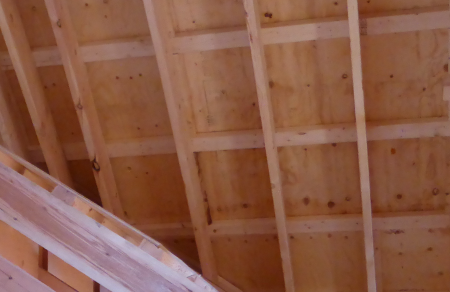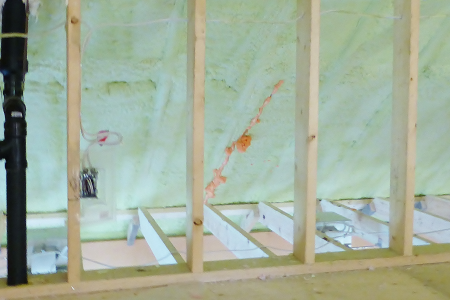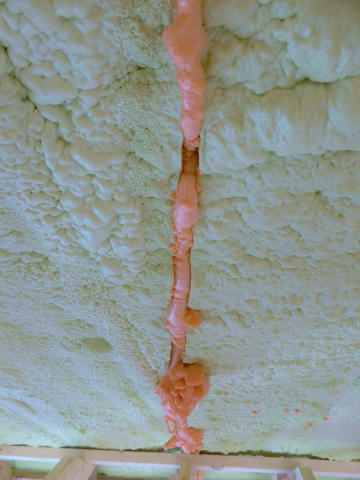When spray foam is applied too thickly in one pass – or ‘lift’ in industry parlance – tension can build and things can start to smell fishy. Unlike nearly all other building materials and components that are manufactured in a controlled environment – like a highly regulated ISO9000 factory – and brought to the job site to be assembled, spray foam is not. Spray foam is manufactured in situ and for this reason that the OBC references the following standards , the first for the product itself, the second or the manufacturer & installer:
The great irony with any standard referenced in the building code is that few contractors have them. Standards get updated often and cost money as a consequence, very few spray foam companies have paid for the standard if they have the most recent version, even fewer spray foam installers have ever seen or read through a copy of the above standards.
I always tell people interested in having their projects insulated with spray foam “Don’t hire the company, hire the guy who pulls the trigger.” I realise, its a chicken before the egg type of question, but the person pulling the trigger doesn’t need to be a Rhodes scholar, but they need over a year of field experience and need to know as much about their trade:
- with a firm grasp of the physics and chemistry effects of time, moisture and temperature on their chemical, the substrate and the finished product,
- building science of how and where to apply the foam,
- physical stamina,
- fastidiousness in keeping clean, clear records,
- discipline for routine daily cleaning and maintenance of the many parts of the system,
- a solid mechanical understanding of generators, proportions and compressors
Medium density spray foam’s chemical is exothermic as it changes from liquid to solid; it makes lots of heat as it cures. To allow the foam to cool, installers limit their ‘lift’ thickness to 2″ per pass. The heat generated is serious and can spontaneously ignite if applied to thickly and quickly – cooling is key. However, when the specifications call for 6″ of spray foam, 3 separate passes should be applied which could take 2-3 days of cooling depending on ambient conditions, but time is money…
In reality, the sprayer typically does two 3″ lifts perhaps all in one day, which can lead to a two serious issues; cracking and smelly finished product. As covered in CBC’s Marketplace a few years back, spray foam can smell sickening and chemically and one of the causes they suspect might be due to lifts being applied too thickly and or successive lifts being applied too quickly.
After visiting a job site recently where the builder shared his experience of hearing the loud crack the foam make when it split in the rafter cavity during spray application, I thought I should check in with a deeply talented insulation expert to get his opinion. I explained what I saw to Michael Cerqua of CallRich Eco Services, and he told me “take a core sample of the spray foam, trim the edges and measure the distance between rings. If it’s more than two inches, the lifts were applied too thickly.” The spray foam industry is very competitive and no one wants to be on a job site for any longer than needed, but Mike stresses that sometimes you just have to wait till the foam cools off – you can’t rush quality when it comes to spray foam, the consequences are too dire.

These 2×8″ rafters were strapped with 2×4″ on the flat side and sheathed. A ventilation chute was installed and the spray foam was applied to the back of the ventilation chute just covering the face of the rafters on the warm side (see below).

Past this knee wall, an orange line (see detail below) can be seen in this 2LBS spray foam filling the rafter cavity. As the sprayer was applying the foam,”You could hear creaking as the foam pulled on the wood framing…” says the builder, “then all of a sudden, with a very loud snap, the foam in the rafter cavity opened up!”

With the blower door running, we detected no air leaks through this 5′ long, repaired (orange can foam) 3/4″ crack in the newly applied 2 LBS spray foam.
